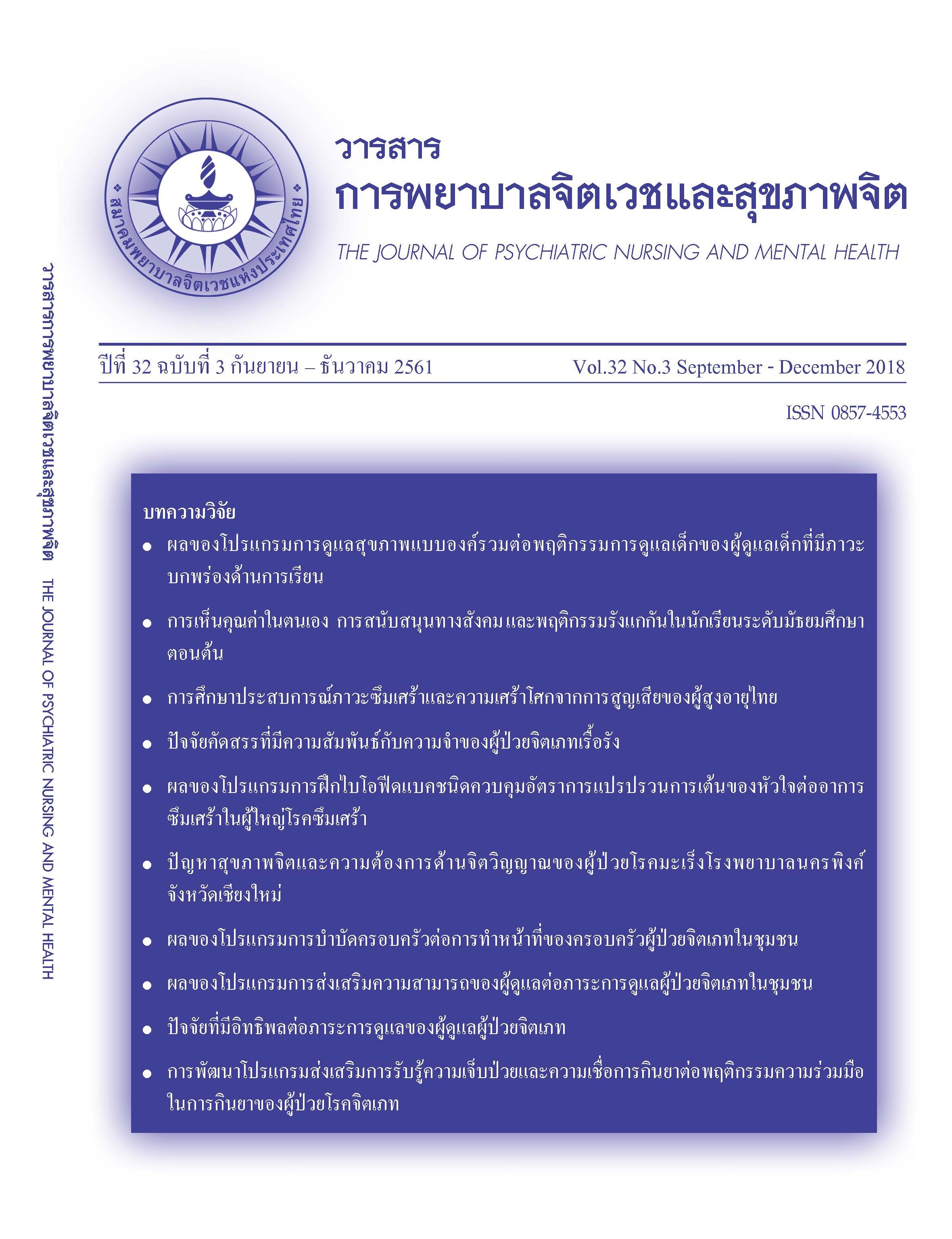ผลของโปรแกรมการส่งเสริมความสามารถของผู้ดูแลต่อภาระการดูแลผู้ป่วยจิตเภทในชุมชน
Main Article Content
บทคัดย่อ
บทคัดย่อ
วัตถุประสงค์: การวิจัยกึ่งทดลองแบบวัดผลก่อนและหลังการทดลองมีวัตถุประสงค์ เพื่อ1) เปรียบเทียบภาระการดูแลผู้ป่วยจิตเภทก่อน และหลังได้รับโปรแกรมการส่งเสริมความสามารถของผู้ดูแล 2) เปรียบเทียบภาระการดูแลผู้ป่วยจิตเภท กลุ่มที่ได้รับโปรแกรมการส่งเสริมความสามารถของผู้ดูแลกับกลุ่มที่ได้รับการพยาบาลตามปกติ
วิธีการศึกษา: กลุ่มตัวอย่าง คือ ผู้ดูแลหลักในครอบครัวของผู้ป่วยจิตเภทซึ่งมารับบริการที่คลินิกจิตเวช แผนกผู้ป่วยนอก โรงพยาบาลทั่วไปแห่งหนึ่ง และมีคุณสมบัติตามเกณฑ์การคัดเข้า จำนวน 40 คน จากนั้นได้รับการจับคู่ด้วยรายได้ของผู้ดูแลแล้วสุ่มเข้ากลุ่มทดลองและกลุ่มควบคุม กลุ่มละ 20 คน โดยกลุ่มทดลองได้รับการดูแลตามแผนการดำเนินกิจกรรมโปรแกรมการส่งเสริมความสามารถของผู้ดูแลที่ผู้วิจัยสร้างขึ้นประกอบด้วยการดำเนินกิจกรรมกลุ่ม 6 ครั้ง เพื่อลดภาระการดูแลผู้ป่วยจิตเภท ส่วนกลุ่มควบคุมได้รับการพยาบาลตามปกติ เครื่องมือที่ใช้ในการวิจัย คือ 1) โปรแกรมการส่งเสริมความสามารถของผู้ดูแล 2) แบบวัดภาระในการดูแลของผู้ดูแลผู้ป่วยจิตเภท ซึ่งผ่านการตรวจสอบความตรงตามเนื้อหาจากผู้ทรงคุณวุฒิ จำนวน 5 ท่าน โดยมีค่าความเที่ยงสัมประสิทธิ์อัลฟาของครอนบาคเท่ากับ .91 วิเคราะห์ข้อมูลโดยใช้สถิติทดสอบที (t-test)
ผลการศึกษา: ผลการศึกษาที่สำคัญสรุปได้ดังนี้ 1) คะแนนเฉลี่ยภาระการดูแลผู้ป่วยจิตเภทของผู้ดูแลหลังได้รับโปรแกรมการส่งเสริมความสามารถของผู้ดูแลต่ำกว่าก่อนได้รับโปรแกรมการส่งเสริมความสามารถของผู้ดูแล อย่างมีนัยสำคัญทางสถิติที่ระดับ .05 2) คะแนนเฉลี่ยภาระการดูแลผู้ป่วยจิตเภทของผู้ดูแลกลุ่มที่ได้รับโปรแกรมการส่งเสริมความสามารถของผู้ดูแลต่ำกว่ากลุ่มที่ได้รับการพยาบาลตามปกติ อย่างมีนัยสำคัญทางสถิติที่ระดับ .05
Article Details
บทความที่ได้รับการตีพิมพ์แล้ว เป็นลิขสิทธิ์ของสมาคมพยาบาลจิตเวชแห่งประเทศไทย
เอกสารอ้างอิง
จิราพร รักการ. (2549). ผลของการใช้โปรแกรมสุขภาพจิตศึกษาครอบครัวต่อภาระในการดูแลของผู้ดูแลผู้ป่วยจิตเภทในชุมชน. วิทยานิพนธ์ปริญญามหาบัณฑิต สาขาวิชาการพยาบาลสุขภาพจิตและจิตเวช, คณะพยาบาลศาสตร์, จุฬาลงกรณ์มหาวิทยาลัย.
จิราภรณ์ นพคุณขจร และจีระพรรณ สุริยงค์. (2551). ผลของโปรแกรมการดูแลผู้ป่วยจิตเวชที่บ้านต่อความเครียดในการดูแลของผู้ดูแลผู้ป่วยโรคจิตเภทและความร่วมมือในการรักษาด้วยยาของผู้ป่วยโรคจิตเภท โรงพยาบาลสวนปรุง จังหวัดเชียงใหม่. กลุ่มการพยาบาล, โรงพยาบาลสวนปรุง จังหวัดเชียงใหม่.
ชนมาภรณ์ พงศ์จันทรเสถียร. (2549). ปัจจัยทำนายการแสดงออกทางอารมณ์ของผู้ดูแลในครอบครัวผู้ป่วยจิตเภท ภาคใต้ตอนบน. วิทยานิพนธ์ปริญญามหาบัณฑิต สาขาวิชาการพยาบาลสุขภาพจิตและจิตเวช, คณะพยาบาลศาสตร์, จุฬาลงกรณ์มหาวิทยาลัย.
ธวัชชัย ลีฬหานาจ. (2552). ตำราโรคจิตเภท. สงขลา: ชานเมืองการพิมพ์.
นพรัตน์ ไชยชำนิ. (2544). ผลของการใช้โปรแกรมการดูแลผู้ดูแลแบบองค์รวมต่อภาระและความสามารถในการดูแลผู้ป่วยจิตเภท. วิทยานิพนธ์ปริญญามหาบัณฑิต สาขาวิชาการพยาบาลสุขภาพจิตและจิตเวช, คณะพยาบาลศาสตร์, จุฬาลงกรณ์มหาวิทยาลัย.
นวนันท์ ปิยะวัฒน์กูล. (2552). ตำราโรคจิตเภท. สงขลา: ชานเมืองการพิมพ์.
มาโนช หล่อตระกูล. (2555). จิตเวชศาสตร์รามาธิบดี (พิมพ์ครั้งที่ 3) .กรุงเทพมหานคร: ภาควิชาจิตเวชศาสตร์ คณะแพทยศาสตร์โรงพยาบาลรามาธิบดี มหาวิทยาลัยมหิดล.
ยุพาพิน ศิรโพธิ์งาม. (2539). ญาติผู้ดูแลที่บ้าน: แนวคิดและปัญหาในการวิจัย. รามาธิบดีพยาบาลสาร, 2(2), 84-94.
สมภพ เรืองตระกูล. (2557). ตำราจิตเวชศาสตร์ (พิมพ์ครั้งที่ 10). กรุงเทพมหานคร: เรือนแก้วการพิมพ์.
Adamec, C. (1996). How to live with mentally ill person. New York: John Wiley & Sons.
Awad, A. G., & Voruganti, L. N. (2008). The burden of schizophrenia on caregivers: A review. Pharmacoeconomic, 26(2), 149 -162.
Bandura, A. (1986). Social foundations of thought and action: A social cognitive theory. Englewood Cliffs, New Jersey: Prentice- Hall.
Burns, N., & Grove, S. (2001). The practice of nursing research: conduct critique and utilization (2nded.). Philadelphia: W.B. Saunder.
Chin, W. T.,Chan, S. W., & Morrissey, J. (2007). The perceived burden among chinese family caregivers of people with schizophrenia. Journal of Clinical Nurse, 16(6), 1151-1161.
Chan, S. W., Yip, B., Tso, S., Cheng, B. S., & Tam, W. (2009). Intervention evaluation of a psychoeducation program for Chinese clients with schizophrenia and their family caregivers. Patient Education and Counseling, 75, 67-76.
Durmaz, H., & Okanli, A. (2014). Investigation of the effect of self-efficacy level of caregiver family members of the individuals with schizophrenia on burden of care. Archives of Psychiatric Nursing, 28(4), 290-294.
Eakes, G. G. (1995). Chronic sorrow: The lived experience of parents of chronically mentally III individuals. Archives of Psychiatric Nursing, 9(2), 77-84.
Hou, S. Y., Ke, C. L., Su, Y. C., Lung, F. W., & Huang, C. J. (2008). Exploring the burden of the primary family caregivers of schizophrenia patients in Taiwan. Psychiatry Clinical Neuroscience, 62(5), 508-514.
Igberase, O. O., Morakinyo, O., Lawan, A. O., James, B. O., & Omoaregba, J. O. (2010). Burden of care among relatives of patients with schizophrenia in Midwestern, Nigeria. International Journal of Social Psychiatry, 58(2), 131-137.
Keefe, R. S. E., Goldberg, T. E., Harvey, P. D., Gold, J. M., & Coughenour, l. (2004). The brief assessment of cognition in schizophrenia: Reliability, sensitivity and comparison with a standard neurocognitive battery. Schizophrenia Research, 68, 283-297.
Kurtz, M. M., Wexler, B. E., Fujimoto, M., Shagan, D. S., & Seltzer, J. C. (2008). Symptoms versus neurocognition a predictors of change in life skills in schizophrenia after outpatient rehabilitation. Schizophrenia Research, 102, 303-311.
Marram, G. D. (1978). The group approach in nursing practice. (2nd ed.). Saint Louis: The C.V. Mosby.
Montgomery, R. J. V., Stull, D. E., & Borgatta, E. F. (1985). Measurement and analysis of burden. Research On Aging, 7(1), 137-152.
Marsh, D., & Johnson, D. (1997). The family experience of mental illness: Implication for intervention professional psychology. Research and Practice, 28(7), 229-237.
Magliano, L., Fiorillo, A., De Rosa, C., Malangone, C., & Maj, M. (2005). Family burden in long-term diseases: A comparative study in schizophrenia vs. physical disorder. Social Science & Medicine, 61(2), 313-322.
Provencher, H. L. (1996). Objective burden among primary caregiver of persons with chronic schizophrenia. Psychiatric and Mental Health Nursing, 3, 188-187.
Schmall, V. L, Cleland, M., & Sturdevant, M. (2000). The caregiver help book (use in the powerful tools for care giving). Oregon, Oregon Gerontological Association: Legacy Health System.
Savundranayagam, M. Y., Montgomery, R. J., Kosloski, K., & Little T. D. (2011). Impact of a psychoeducational program on three types of caregiver burden among spouses. International Journal of Geriatric Psychiatry, 26, 388-396.
Yikilkan, H., Aypak, C., & Gorpelioglu, S. (2014). Depression, anxiety and quality of life in caregivers of long-term home care patients. Archives of Psychiatric Nursing, 28(3), 193-196.


